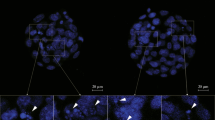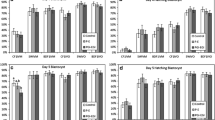Abstract
We studied the effect of the growth factor LIF on the development of parthenogenetic mouse embryos (CBA × C57BL/6)F1. LIF was added to the culture medium at 10, 50, 100, and 250 ng/ml at the morula stage and parthenogenetic embryos were cultured in vitro until the late blastocyst stage and then transplanted in the uterus of pseudopregnant females, which were then sacrificed on day 12 of pregnancy. All the LIF doses used improved the development of parthenogenetic mouse embryos at the preimplantation stages and increased the amount of blastocysts by 15%, on average, as compared to the control. LIF at 50 and 100 ng/ml increased approximately twice the number of embryos that reached the somite stages. Some of them reached the stage of 32–45 somites and had fore and hind limb buds. No such embryos were found in the control. Well formed placenta was observed in 6% of the embryos treated with LIF and the most pronounced effect was recorded at 100 ng/ml. The data we obtained suggest that exogenous LIF can improve pre- and postimplantation development of parthenogenetic mouse embryos due, possibly, to increased survival rate of embryonic stem cells derived from the inner cell mass of blastocysts. LIF improves not only the development of the parthenogenetic embryoper se, but also the formation of its extraembryonic envelopes, which leads to the development of a larger placenta in LIF-treated parthenogenetic embryos, as compared to the control.
Similar content being viewed by others
References
Abramczuk, J., Solter, D., and Koprowski, H., The Beneficial Effect of EDTA on Development of Mouse One-Cell Embryos in Chemically Defined Medium, Dev. Biol., 1977, vol. 61, pp. 378-383.
Allen, N.D., Barton, S.C., Hilton, K., et al., A Functional Analysis of Imprinting in Parthenogenetic Embryonic Stem Cells, Development (Cambridge, UK), 1994, vol. 120, pp. 1473-1482.
Chen, H.F., Shew, J.Y., Ho, H.N., et al., Expression of Leukemia Inhibitory Factor and Its Receptor in Preimplantation Embryos, Fertil. Steril., 1999, vol. 72, pp. 713-719.
Dunglison, G.F., Barlow, D.H., and Sargent, I.L., Leukaemia Inhibitory Factor Significantly Enhances the Blastocyst Formation Rates of Human Embryos Cultured in Serum-Free Medium, Hum. Reprod., 1996, vol. 11, pp. 191-196.
Dyban, A.P. and Khozhai, L.I., Parthenogenetic Development of Ovulated Mouse Eggs under the Influence of Ethanol, Byull. Eksp. Biol. Med., 1980, vol. 139, pp. 487-489.
Fry, R.C., The Effect of Leukaemia Inhibitory Factor (LIF) on Embryogenesis, Reprod. Fertil. Devel., 1992, vol. 4, pp. 449-458.
Gearing, D.P., Gough, N.M., King, J.A., et al., Molecular Cloning and Expression of CDNA Encoding a Murine Myeloid Leukaemia Inhibitory Factor (LIF), EMBO J., 1987, vol. 6, pp. 3995-4002.
Gough, N.M., Williams, R.L., Hilton, D.J., et al., LIF: A Molecule with Divergent Actions on Myeloid Leukaemic Cells and Embryonic Stem Cells, Reprod. Fertil. Devel., 1989, vol. 1, pp. 281-288.
Hogan, B., Constantini, F., and Lacy, E., Manipulating the Mouse Embryo: A Laboratory Manual, New York: Cold Spring Harbor Laboratory, 1986, pp. 132-134.
Humpherys, D., Eggan, K., Akutsu, H., et al., Epigenetic Instability in ES Cells and Cloned Mice, Science, 2001, vol. 293, pp. 95-97.
Kaufman, M.H., The Chromosome Complement of Single Pronuclear Haploid Mouse Embryos, Following Activation by Ethanol Treatment, J. Embryol. Exp. Morphol., 1982, vol. 71, pp. 139-154.
Kaufman, M.H., Barton, S.C., and Surani M.A.H., Normal Postimplantation Development of Mouse Parthenogenetic Embryos to the Forelimb Bud Stage, Nature (London), 1977, vol. 265, pp. 53-55.
Kauma, S.W. and Matt, D.W., Coculture Cells That Express Leukemia Inhibitory Factor (LIF) Enhance Mouse Blastocyst Development in vitro, J. Assist. Reprod. Genet, 1995, vol. 12, pp. 153-156.
Konyukhov, B.V. and Isaev, D.A., Use of Chimeric Mice for Studying the Effects of Genomic Imprinting, Ontogenez (Moscow), 2000, vol. 31, no. 5, pp. 360-367.
Konyukhov, B.V. and Platonov, E.S., Genomic Imprinting in Mammals, Genetika, 2001, vol. 37, no. 1, pp. 5-17.
Lyashenko, A.A. and Uvarov, V.Yu., On the Problem of Classification of Cytokines, Usp. Sovrem. Biol., 2001, vol. 121, no. 6, pp. 589-603.
Morrish, D.W., Dakour, J., and Li, H., Functional Regulation of Human Trophoblast Differentiation, J. Reprod. Immunol., 1998, vol. 39, pp. 179-195.
Murray, P. and Edgar, D., The Regulation of Embryonic Stem Cell Differentiation by Leukaemia Inhibitory Factor (LIF), Differentiation (Berlin), 2001, vol. 68, pp. 227-234.
Murray, R., Lee, F., and Chiu, C.P., The Genes for Leukemia Inhibitory Factor and Interleukin-6 Are Expressed in Mouse Blastocysts prior to the Onset of Hemopoiesis, Mol. Cell Biol., 1990, vol. 10, pp. 4953-4956.
Nachtigall, M.J., Kliman, H.J., Feinberg, R.F., et al., The Effect of Leukemia Inhibitory Factor (LIF) on Trophoblast Differentiation: A Potential Role in Human Implantation, J.?Clin. Endocrinol. Metab., 1996, vol. 81, pp. 801-806.
Newman-Smith, E.D. and Werb, Z., Stem Cell Defects in Parthenogenetic Periimplantation Embryos, Development (Cambridge, UK), 1995, vol. 121, pp. 2069-2077.
Pease, S. and Williams, R.L., Formation of Germ-Line Chimeras from Embryonic Stem Cells Maintained with Recombinant Leukemia Inhibitory Factor, Exp. Cell Res., 1990, vol. 190, pp. 209-211.
Penkov, L.I. and Platonov, E.S., Ultroser-G and 5-Azacytidine prolong the Development of Parthenogenetic Mouse Embryos, Ontogenez (Moscow), 1997, vol. 28, no. 2, pp. 138-144.
Penkov, L.I. and Platonov, E.S., Effects of Fibroblast Growth Factors (FGF-2 and FGF-4) on Development of Parthenogenetic Mouse Embryos, Ontogenez (Moscow), 1999, vol. 30, no. 6, pp. 448-452.
Penkov, L.I., Platonov, E.S., Mironova, O.V., and Konyukhov, B.V., Effects of 5-Azacytidine on the Development of Parthenogenetic Mouse Embryos, Devel. Growth Differ., 1996, vol. 38, pp. 263-270.
Penkov, L.I., Platonov, E.S., and New, D.A.T., Effects of Fibroblast Growth Factor 2 And Insulin-like Growth Factor II on the Development of Parthenogenetic Mouse Embryos in vitro, In Vitro Cell Devel. Biol. Animal., 2001, vol. 37, pp. 440-444.
Platonov, E.S., Penkov, L.I., and Konyukhov, B.V., Transforming Growth Factor α?(TGFα) Modulates the Effects of Genomic Imprinting and Prolongs the Development of Parthenogenetic Mouse Embryos, Genetika, 2001, vol. 37, no. 10, pp. 1358-1363.
Platonov, E.S., Penkov, L.I., and New, D.A.T., Effects of Two Growth Factors FGF2 and IGF2 on Development of Parthenogenetic Mouse Embryos in utero and in vitro, Ontogenez (Moscow), 2002, vol. 33, no. 1, pp. 60-67.
Rathjen, P.D., Nichols, J., Toth, S., et al., Developmentally Programmed Induction of Differentiation Inhibiting Activity and the Control of Stem Cell Populations, Genes. Devel., 1990, vol. 4, pp. 2308-2318.
Rossant, J., Stem Cells from the Mammalian Blastocyst, Stem Cells, 2001, vol. 19, pp. 477-482.
Sasaki, H., Ferguson-Smith, A.C., Shum, A.S., et al., Temporal and Spatial Regulation of H19 Imprinting in Early Embryogenesis, Development (Cambridge, UK), 1995, vol. 121, pp. 4195-4202.
Surani M.A.H., Barton, S.C., Development of Gynogenetic Eggs in the Mouse: Implication for Parthenogenetic Embryos, Science, 1983, vol. 222, pp. 1034-1036.
Surani M.A.H., Barton, S.C., Norris, M.L., Development of Reconstituted Mouse Eggs Suggests Imprinting of the Genome during Gametogenesis Nature (London), 1984, vol. 308, pp. 548-550.
Tsai, H.D., Chang, C.C., Hsieh, Y.Y., et al., Effect of Different Concentrations of Recombinant Leukemia Inhibitory Factor on Different Development Stage of Mouse Embryo in vitro, J. Assist. Reprod. Genet., 2000, vol. 17, pp. 352-355.
Wilkinson, D.G., Whole Mount in situ Hybridization of Vertebrate Embryos, In Situ Hybridization: A Practical Approach, Wilkinson, D.G., Ed., Oxford: IRL, 1992, pp. 75-83.
Author information
Authors and Affiliations
Rights and permissions
About this article
Cite this article
Penkov, L.I., Platonov, E.S., Kondrakhina, M.S. et al. Leukemia Inhibitory Factor (LIF) Improves and Prolongs the Development of Parthenogenetic Mouse Embryos. Russian Journal of Developmental Biology 34, 249–253 (2003). https://doi.org/10.1023/A:1024900717307
Issue Date:
DOI: https://doi.org/10.1023/A:1024900717307




